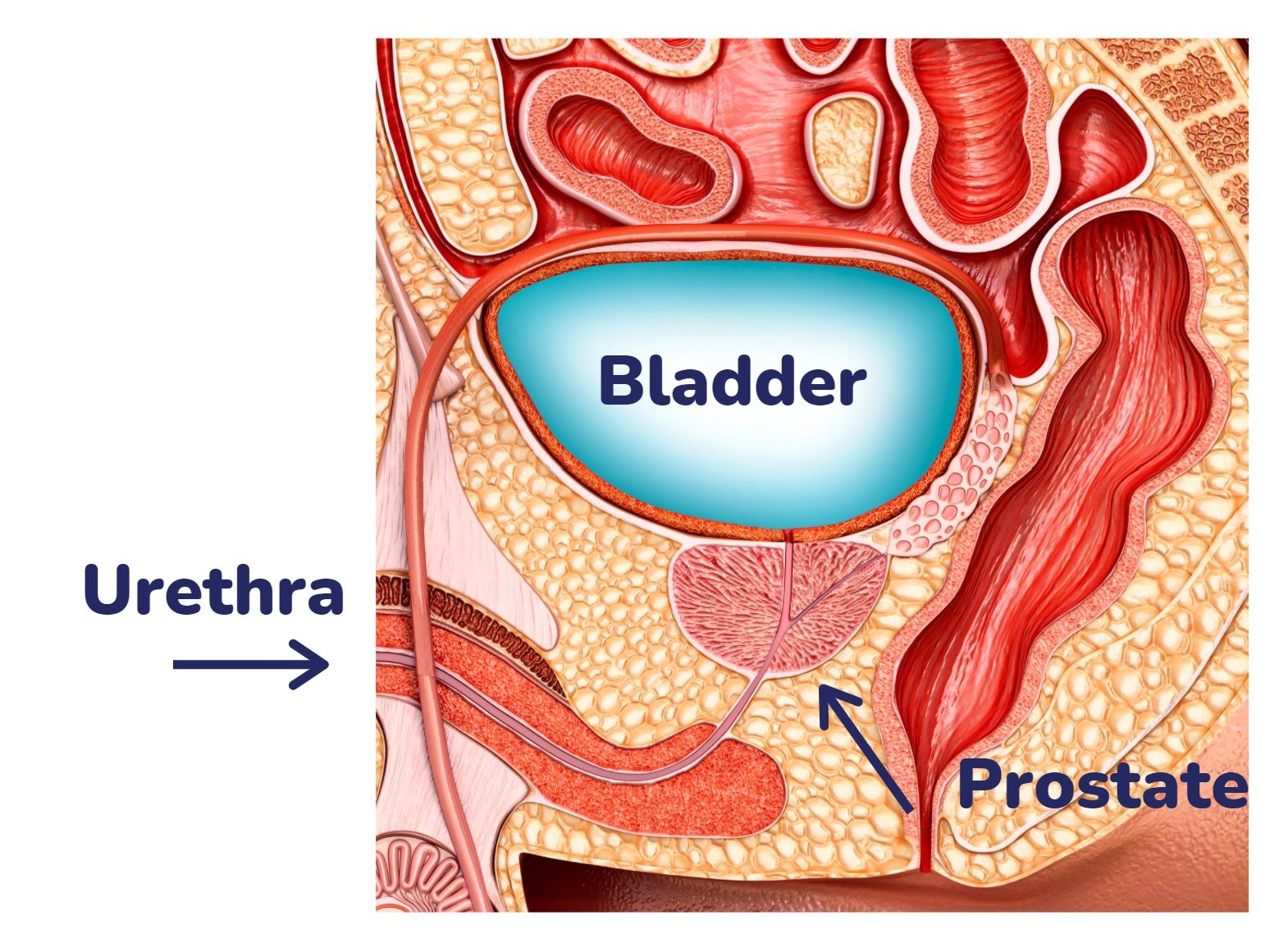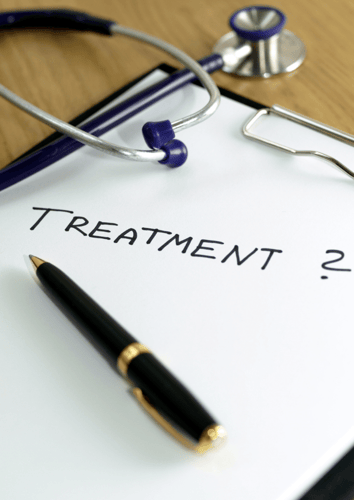Prostate Conditions
What is the Prostate?
The prostate gland is a small, walnut-sized gland located just beneath your bladder and in front of your rectum, which is responsible for producing the semen which nourishes and transports sperm during ejaculation.

The tube which transports urine from the bladder to the penis (the urethra) passes straight through the prostate. When the prostate becomes enlarged due to various conditions, it can restrict the urethra and cause difficulty in urination.
In many men, an enlarged prostate is a common condition that comes with age, and is usually not difficult to treat. There are three main conditions which affect the prostate: prostatitis, benign prostatic hyperplasia, and prostate cancer.
What is the Normal Weight and Size of the Prostate?
A healthy adult prostate weighs around 20 to 25 grams and is approximately 4 cm wide, 3 cm high, and 2 cm thick.
Prostates can be measured on a size scale:
- A small prostate has a volume of 30 ml to 40 ml and a weight of 20 g to 70 g,
- A medium prostate has a volume of 40 ml to 80 ml and a weight of 20 g to 125g, and
- A large prostate has a volume of 40ml to 100 ml and a weight of 40 g to 125 g.
Conditions such as benign prostatic hyperplasia can increase the size and weight of the prostate by up to 5 times its normal size.

Benign Prostatic Hyperplasia (BPH)
What is Benign Prostatic Hyperplasia?
Benign Prostatic Hyperplasia (BPH) is an enlargement of the prostate gland which is not related to cancer. It is a common condition in older men, affecting around 1/3 of men over 50 and 60% of men over 60.
It occurs when the cells in your prostate gland start multiplying, which causes the gland to increase in size and squeeze the urethra.
BPH is definitely not the same as prostate cancer and does not put you at a greater risk of developing cancer, but it can be uncomfortable and impact your quality of life.
What causes Benign Prostatic Hyperplasia?
BPH is, unfortunately, considered a normal condition that comes as men get older. While we don’t know the exact cause of benign prostatic hyperplasia or the cause of enlarged prostates in general, it is generally accepted that changes in hormones as a result of age may be a significant contributing factor.
What are the symptoms of Benign Prostatic Hyperplasia?
The symptoms of BPH include:
- A burning sensation or otherwise painful urination (known as dysuria)
- Difficulty urinating, such as dribbling or hesitant urination
- Frequent urination, particularly at night (known as nocturia)
- An urgent need to urinate
- Straining to urinate
- Incontinence
- Difficulty emptying your bladder, or experiencing dribbling at the end of urinating
- Cloudy urine
- Blood in the urine
Recommended Reading: Learn more about the symptoms of an enlarged prostate and BPH.
Key Figures, Data, and Statistics on BPH
- Genetics has been shown to have a significant impact on your risk of developing prostate conditions such as BPH. A case-control analysis, in which men below 64 years underwent surgery for BPH, noted that male relatives and brothers had a 4-fold and 6-fold increase in risk. Source.
- Several lifestyle factors are associated with an increased risk of developing BPH, including diet. An increased total energy intake, energy-adjusted total protein intake, red meat, fat, milk and dairy products, cereals, bread, poultry, and starch all potentially increase the risks of clinical BPH and BPH surgery, while vegetables, fruits, polyunsaturated fatty acids, linoleic acid, and vitamin D potentially decrease the risk of BPH. Source. Source.
- An analysis of 11 studies, found that those who exercised at a moderate to vigorous level reduced their risk of BPH by 25% compared to those who lived a sedentary lifestyle. Source.
- Alcohol appears to have a protective effect against BPH. An analysis of 19 studies found a 35% decrease in the likelihood of developing BPH in men who drank daily. Source.
- Bodyweight, body mass index (BMI), and waist circumference have all been positively associated with prostate volume in multiple different studies. Source.
Is BPH connected to Prostate Cancer?
BPH is not linked to prostate cancer, and suffering from it does not increase your risk of developing prostate cancer. However, symptoms for BPH and prostate cancer can be very similar. As a result, you will need to be thoroughly screened for signs of prostate cancer before undergoing treatment for BPH.
➡️ Featured Resource: A Simple Guide to Prostate Health
Safe, effective treatments with less pain and quicker recovery.
Ensure you know all your options prior to invasive surgical treatment, schedule a consult with Dr Shaun Quigley.
What Puts You More at Risk for Prostate Conditions?
- Age – prostate conditions become more common with age as the prostate continues to grow throughout most of your life. In some men, this causes it to compress the urethra and cause lower urinary tract symptoms (LUTS).
- Family history – if men in your family have been diagnosed with a prostate condition (especially prostate cancer), you are more likely to eventually suffer from the condition yourself. Having a father or brother who has prostate cancer more than doubles your risk of developing it yourself.
- Diet – no study has been able to conclusively prove that nutrition can cause or prevent prostate conditions, but many studies have shown that there may be a connection between diet and certain conditions, particularly cancers. No specific vitamins, minerals, or other supplements have been conclusively proven to help prevent prostate cancer.
- Ethnicity – although the reason as to this is unclear, prostate conditions (particularly cancer) tend to develop more often in men of African descent and less often in men of Asian and Hispanic descent.
- Obesity – obesity has been shown to be a risk factor for a wide variety of health conditions, including many types of cancer. Losing excess weight could potentially reduce your chances of contracting a prostate condition (particularly prostate cancer).
How are Prostate Conditions Diagnosed?
Testing for prostate conditions involves a physical exam, as well as a number of questions about your personal and family medical history.
A variety of scans and tests can also be used to determine whether or not you have a prostate condition and its severity. These include a digital rectal examination, prostate-specific antigen (PSA) blood test, urine flow study, ultrasounds, prostate biopsy, or a prostate MRI:
Digital Rectal Examination (DRE) – your healthcare professional inserts a gloved and lubricated finger into the rectum and feels the prostate for any hard, lumpy, or otherwise abnormal areas. This process only takes a few minutes and does not cause significant pain.
Prostate-Specific Antigen (PSA) blood test – this is used to help detect prostate cancer, but can also detect non-cancerous causes for prostate issues. The PSA blood test assesses the levels of PSA (a hormone produced by the prostate) in the bloodstream and uses the level to assess whether or not you may have a prostate condition.
Urine Flow Study – this test involves urinating into a device that can measure the flow rate and quantity of urine produced.
Ultrasounds – transrectal and transabdominal ultrasounds can be used to assess the size of the prostate and the amount of urine left in the bladder after urination.
Prostate Biopsy – in this test, the physician removes small slivers of the prostate tissue with a tiny needle, which can then be examined under a microscope for signs of a condition.
Prostate MRI – this provides a view of the entire prostate and can be used to assess its size. It is also increasingly used to detect prostate cancer.

Treating Prostate Conditions
When it comes to treating prostate conditions, there are a range of treatment options available to you, depending on your situation. These include medication, natural treatment, major surgery, and prostatic artery embolisation.
Lifestyle Change
For men suffering mild symptoms, making lifestyle changes is often enough to help provide some relief from symptoms of an enlarged prostate. These changes include:
- Dietary changes - cutting back on red meat, reducing alcohol and caffeine consumption, and quitting smoking are just some of the changes you can make to find relief.
- Exercise - working up a sweat for 30 mins most days of the week can result in symptom relief.
- Stress management - studies have shown that stress can aggravate the symptoms of BPH, usually leading to a cycle of stress (symptoms leads to stress, which leads to worse symptoms, which leads to more stress, and so on).
Recommended Reading: Diet, Exercise & Stress Management - 3 Tips to Improve Prostate Health
Medication
The first line treatment option is management through medication. This can be effective but unfortunately is limited in most men by either cardiovascular side effects (dizziness, fainting) or sexual dysfunction (impotence, reduced libido).
There are several medications that can help to both treat the symptoms of BPH and BPH itself. These medications include:
Alpha-1 Blockers
Alpha-1 blockers relax the neck of the bladder and allow urine to flow easier. They relax your muscles and open arteries, helping reduce blood pressure.
Unfortunately, most alpha-blockers need to be taken for life. Common side effects include nausea and lightheadedness, dizziness and headaches.
Antibiotics
Antibiotics can also be prescribed if you are suffering from bacterial prostatitis.
Natural Treatment for BPH
We use the term natural here to describe lifestyle changes you can make to reduce the symptoms of your prostate condition.
The strongest advice we usually give is for sufferers to reduce their alcohol and caffeine consumption, especially in the evening. [highlight for emphasis]
Other things you can do to reduce symptoms include:
- Avoiding over-the-counter decongestants or antihistamine medications, which can make it harder for the bladder to empty
- Reducing or avoiding alcohol and caffeine, especially in the evening
- Reducing your stress level, as nervousness can increase the frequency of urination
- Exercising regularly, even light to moderate activity, can help reduce symptoms and improve overall general health
- Learning and practicing Kegel exercises to strengthen your pelvic muscles
There is very little scientific evidence to support any claims for natural remedies treating BPH or other prostate conditions.
Major Surgery to Treat BPH
When it comes to treating BPH, most general practitioners refer patients for TURP, Transurethral Resection of the Prostate. This is where a large tube inserted via the penis is used to core away the inside of the prostate. Whilst this does improve symptoms, it comes with surgical risk and is strongly associated with incontinence and retrograde ejaculation (failure to ejaculate on orgasm).
Other urological treatment options come with similar invasive nature and risks (Laser/greenlight) or are less well established and still require entry via the penis (eg. urolift).
Prostatic Artery Embolisation
Prostatic Artery Embolisation (PAE) is an innovative procedure used to treat benign prostate hyperplasia (BPH) – a condition resulting in the enlargement of a prostate - a common cause for lower urinary tract symptoms (LUTS).
It is considered to be a safe and effective method of symptom reduction and has been shown to yield great results: over 90% of men gain symptomatic improvement (decreases in prostate volume and increases in urinary flow rates) following the procedure, and undergoing PAE doesn’t prevent you from undergoing other prostate reduction procedures later on.
This is a complex procedure which can only be performed by a specialist interventional radiologist with expertise in the area.

Safe, effective treatments with less pain and quicker recovery.
Ensure you know all your options prior to invasive surgical treatment, schedule a consult with Dr Shaun Quigley.



